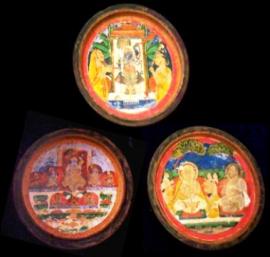Painting
The Museum of Jnana-Pravaha houses some important specimens of miniature paintings, which were basically prepared for manuscripts and meditation, from the collection of Mr. Suresh Neotia. Though modest, it gives a bird's-eye view of several major schools and sub-styles of Indian paintings, such as Pala, Western India (Gujarat), Popular Mughal, Bikaner, Malwa, Mewar, Amer, Jaipur, Sirohi, Raghogarh, Bundi, Kishangarh, Jodhpur, Nathadwara, Datia, Pahari, (Mandi, Kangra, Shangri, Garhwal, Nalagarh, Guler), Company and Mysore. Nepal is represented by a Mandala Thanka and book-covers with miniatures. Tibet is introduced by a beautiful Thanka with a Buddhist saint. The collection is particularly rich in Bikaner miniatures. Besides paper, palm-leaves, parchment (charba), ivory, wood and cloth have also been used. Chronologically, these range from circa 13th century to the early 20th century. Some of the painted wood-covers (patali) used for the safety of the illustrated manuscripts are quite interesting. Like other works, the paintings in most of the cases are anonymous but we do find the name of one artist, Muhammad from Bikaner. The subject matter varies from religious themes to garden party, sports, portraits, hunting and battle scenes, heroes and heroines (nayikabheda), musical modes (raga-ragini), festivals, ceremonies, etc. While some paintings are of high aesthetic merit, the others are important for their style and rarity. A few paintings and manuscripts being dated, assume historical significance. The Sadhanamala sketchbook on display is of unique significance.
|
|
|


